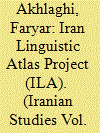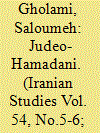| Srl | Item |
| 1 |
ID:
179398


|
|
|
|
|
| Summary/Abstract |
This article describes a dialectal variant of the Georgian language in Iran, Fereydani Georgian, which has survived in Iran for about 400 years. Various relevant aspects of the history and research on Fereydani Georgian are analysed. The choice of topics and sources focuses on previously unknown or, for the English-speaking reader, inaccessible authors. Since 2009, a large part of the linguistic data has been collected in several field studies in Fereydan. They serve as sources and show a revealing perspective on the origin, preservation and existence of the Georgian language island of Fereydani in Iran.
|
|
|
|
|
|
|
|
|
|
|
|
|
|
|
|
| 2 |
ID:
179402


|
|
|
|
|
| Summary/Abstract |
Iran Linguistic Atlas (ILA), funded by the Research Institute for Cultural Heritage and Tourism (RICHT), is a research project for mapping the linguistic diversity of Iran. The project is aimed at recording unified and comparable data from every spoken dialect of Iran’s rural areas and producing self-organized colored maps of this diversity using a specialized software program. Its initial phase began around the mid-1970s in the form of a joint project by the then Iranian Academy of Language and the National Geography Organization. In 2001, the documented data was handed over to the Cultural Heritage Organization, to be saved and expanded. The Iran Linguistic Atlas has now been redefined as an automatic linguistic atlas with the capability of producing self-organizing colored maps according to the operator’s choices. In this article, the ILA, its background and the state of its current phase is introduced. The nature of its data, its earlier and recent field methods, its audiotapes, digital databases and computer databases of phonetic transcriptions are described. In addition, ILA software program is presented and its capability for creating automatic colored maps is discussed thoroughly.
|
|
|
|
|
|
|
|
|
|
|
|
|
|
|
|
| 3 |
ID:
180017


|
|
|
|
|
| Summary/Abstract |
The study of the language of religious minorities in Iran is particularly important for understanding the historical development and typology of Iranian languages. Historical and linguistic evidence substantiates the idea that Zoroastrians and Jews in cities in central and western Iran preserved their former vernacular language, whereas the majority of the population replaced it with Persian in the New Iranian period. This paper focuses on the language of Jews in Hamadan and has two main objectives: first, it examines numerous distinctive features of Judeo-Hamadani; second, it reviews and updates recent research to clarify the language origins, using data from new materials recorded during fieldwork in Hamadan from October 2018 to August 2019, and in Yazd in 2017.
|
|
|
|
|
|
|
|
|
|
|
|
|
|
|
|